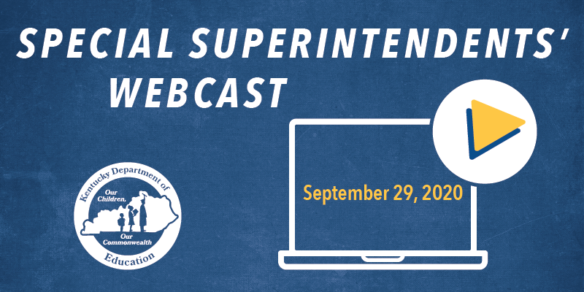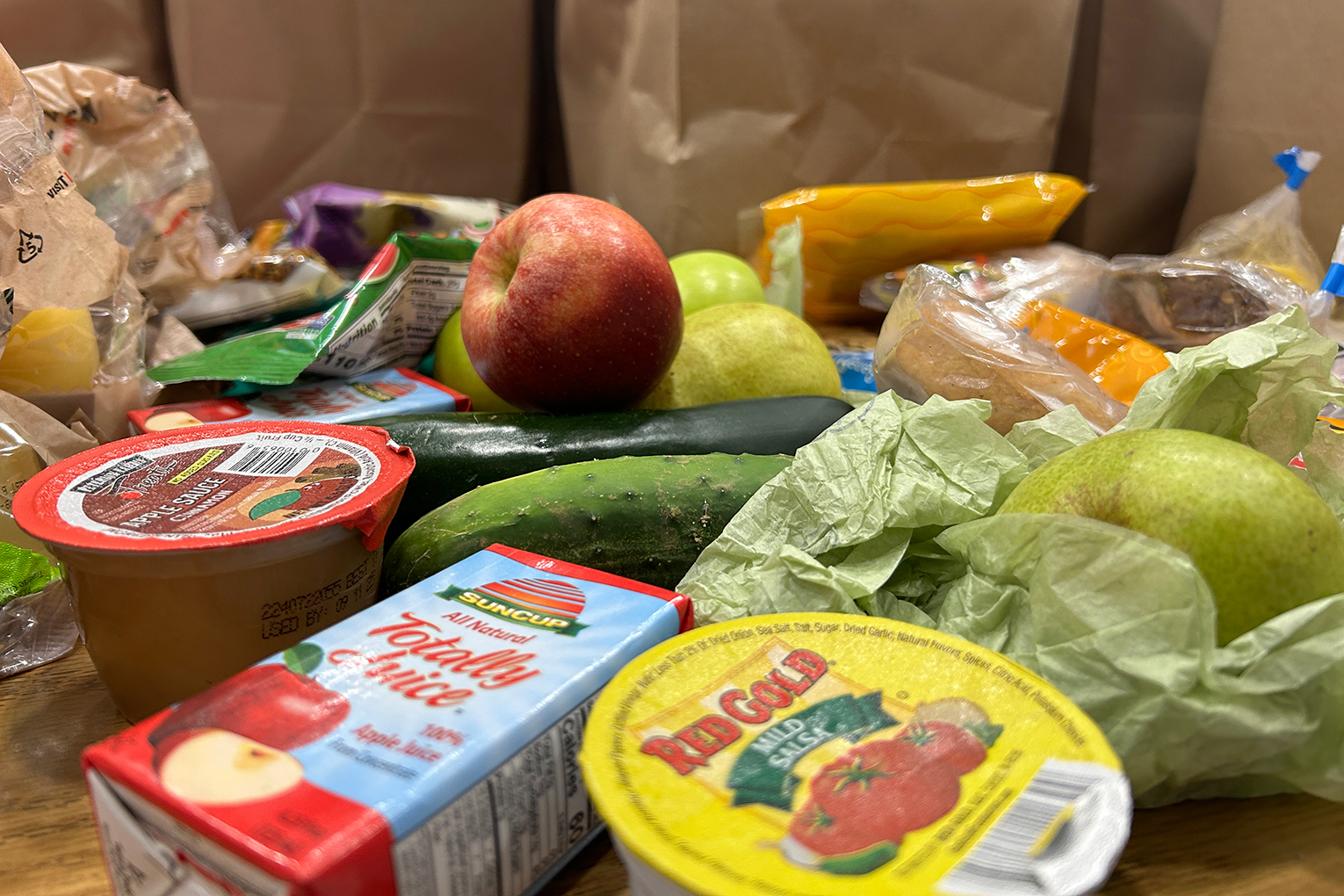
By Jim Gaines
jim.gaines@education.ky.gov
Participants in the Kentucky Department of Education’s Sept. 29 Special Superintendents’ Webcast heard from leaders of four school districts on how reopening to in-person instruction amid the pandemic has gone so far, and from state officials about updates to the color-coded metric used to determine whether to hold in-person classes.
While most Kentucky public schools reopened for in-person classes on Sept. 28, some reopened earlier, and the four superintendents discussed what worked and what needed improvement based on their experiences.
During the meeting, an official with the Kentucky Department for Public Health (DPH) also discussed changes to the new color-coded metric schools are now being asked to use in deciding when to suspend in-person classes based on COVID-19 cases in the community. The metric aims to give districts guidance on whether it is safe to reopen school buildings by considering community spread.
Health Updates
Schools are required to report positive COVID-19 tests to DPH, and the self-reporting dashboard on the Team Kentucky website is now live, said Dr. Connie White, deputy commissioner of DPH. The daily reports posted there won’t necessarily match the K-12 School Public Health Report which DPH puts out, but the verified DPH report takes longer to assemble, she said.
The daily dashboard schools use to report cases and quarantines is meant to give districts real-time data on which to quickly make opening and closing decisions.
The metric, which uses four colors to denote community spread, originally was released Sept. 14 and has been updated to say that districts in the “red zone” don’t have to wait on reopening until the “yellow” level is reached, White said. They only must wait until they drop to a lower level, whether orange, yellow or green. After talking with stakeholders, health officials decided waiting for a drop to yellow was too onerous for districts to implement, White said.
Officials were asked by the superintendents why the recommendations should be followed even if there is not a significant increase in cases in schools themselves.
Jason E. Glass, Kentucky commissioner of education and chief learner, said it is “because the positivity rates in your community matter.”
He noted that schools don’t exist in isolation and transmission elsewhere in a community increases the risk that COVID-19 will spread in schools too. Other factors include how well people are adhering to health guidelines and the available supply of personal protective equipment and sanitization products.
Superintendents Discuss Reopening
The COVID-19 pandemic presents a “maybe once-in-a-lifetime challenge” for educators, said Glass. Schools have had to reexamine everything they do, so it is helpful to share ideas from districts that already have reopened for in-person classes, he said.
Glass said people should be confident that the pandemic will end, but should accept that it will take a long time. They shouldn’t pin hopes on a specific date for a return to normal, he said.
Superintendent Steve Carter of McCracken County Public Schools said his district called all families in mid-July to see how they wanted to restart classes. Eighty percent wanted full in-person school, he said. The district has 6,682 students.
McCracken County began Aug. 24 with a virtual week, and now about 72% of enrolled students are attending in a hybrid model, with two groups coming to class on alternate days, Carter said. Monday is a virtual planning day.
Almost all of the district’s 950 employees indicated they were comfortable with returning to in-person class, Carter said. McCracken County changed its school day start and end times so bus routes could be modified, he said.
The district found that internal and external communication is critical. The plan for returning to school is posted online with all related information, Carter said.
One difficulty has been ensuring internet access for every student, though the district has set up 140 wireless hotspots, he said.
Superintendent Taylora Schlosser of Marion County Public Schools said a community survey found 75% of local families wanted to return to in-person learning for the district’s 3,150 students. After two weeks of distance learning, in-person classes started Aug. 26, and that 75% figure was right on target, she said. Parents can opt to change whether their child attends virtually or in-person every four weeks; now in-person attendance has risen to 80%, Schlosser said.
Students have adapted well to mask-wearing and drive-through orientation events for parents have been successful, she said.
It has been difficult to cover for absent teachers, deal with frequent changes in public health guidance and communicate important information, Schlosser said.
Josh Hurt, new to the job of superintendent of Metcalfe County Schools, said his community was split almost evenly on whether to conduct classes in person or virtually. About 750 students – half the total – returned for in-person classes on Aug. 31, he said. Classes are four days a week, with Friday as a virtual learning day for everyone.
Things went smoothly the first four weeks, but it has been difficult having students bouncing between in-person and virtual classes, Hurt said. Stress is high for teachers and support staff due to the extra workload.
Metcalfe schools had to go to all virtual learning Sept. 28 due to a staff member testing positive for COVID-19 after being around other staff members, requiring many to quarantine, Hurt said.
Superintendent Alvin Garrison of Covington Independent Public Schools said his district, which opened for in-person classes on Sept. 28, learned from those that opened earlier.
Covington is using a hybrid model for its 4,024 students, alternating groups of students on different days, with Wednesday as a teacher planning day. Online tutoring for all students is available 24/7, Garrison said.
In a few weeks the district will assess the situation and hopes to return to full in-person instruction four days per week, he said.
Distribution of food and computers has worked well, but the district has had to rent some computers in the interim because ones ordered for elementary students haven’t arrived, Garrison said.
Changing guidance has been an issue, as has finding adequate staff to cover classes in case of a disease outbreak, he said.
Aerosol Transmission Statement
A consensus statement from Kentucky health officials, approved Sept. 29 by Gov. Andy Beshear, says COVID-19 “may also spread via aerosol transmission.” That is different from transmission by larger respiratory particles, which drop off after about 6 feet, said White.
Current social distancing guidelines are based on that 6-foot radius, but smaller aerosol particles may travel farther and hang in the air for much longer, according to the statement.
That’s why improving ventilation to reduce those aerosol particles is critical, White said.
The health consensus maintains that exposure requiring quarantine won’t be judged solely on the grounds of extended proximity to an infected person, so long as everyone wore masks, remained at least 6 feet apart, and weren’t engaged in high-risk activities such as singing or cheering.
Classrooms and some work environments will be considered controlled settings under which this guidance applies, but it won’t apply to households or social settings where compliance hard to monitor.
Masks for Schools
About 60 to 70 of the state’s 171 school districts say they still need face masks, and the Kentucky Department of Education (KDE) is coordinating with First Lady Britainy Beshear’s office to supply them through the Coverings for Kids program, KDE Interim Director of Communications Toni Tatman said. Districts that have more masks than they need are asked to email Tiffany Meredith so those extras can be sent to districts that need them.
Federal authorities are sending more than 2 million masks to Kentucky schools, half adult sized and half youth sized, Tatman said. They will be available through DPH’s regional distribution centers, as the supply of no-touch thermometers was in July, she said. School districts will be emailed information as soon as the masks are ready for distribution.
P-EBT Funding
A second round of student meals through the Pandemic Electronic Benefit Transfer (P-EBT) program is coming, Tatman said. Eligibility is based on participation in the National School Lunch Program, school start dates and instruction methods. Some students may not get their new P-EBT cards until November.
All questions about P-EBT should be directed to the Kentucky Cabinet for Health and Family Services at (855) 306-8959.
MORE INFO …
- Sept. 29 Special Superintendents’ Webcast
- KDE’s COVID-19 webpage
- KDE’s COVID-19 Reopening Guidance webpage
- Kentucky COVID-19 Hotline (800) 722-5725




Leave A Comment